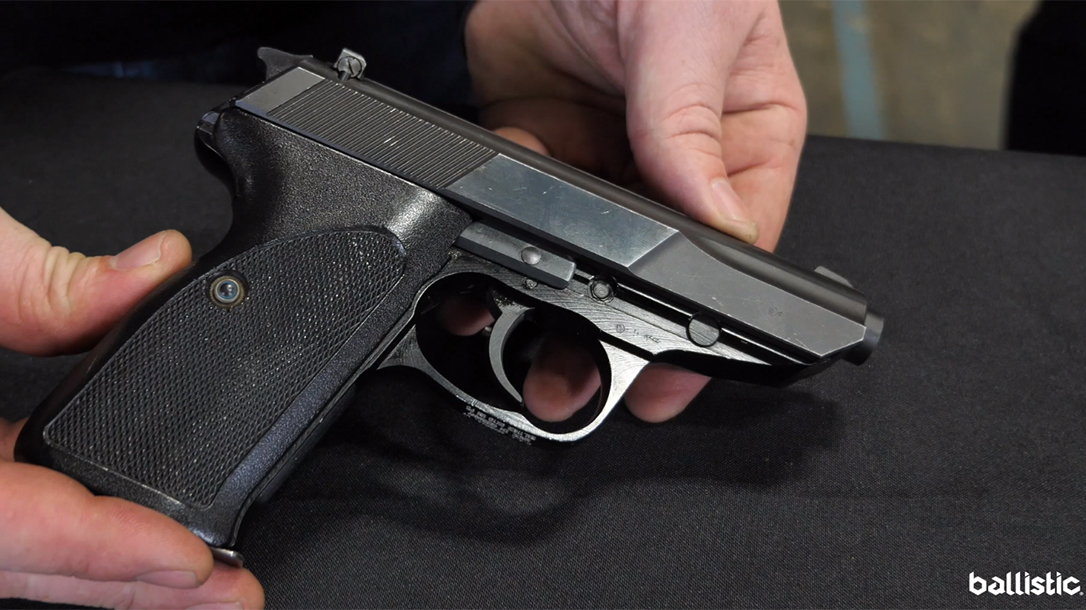Before we get to the Walther P5, let’s focus on Century Arms. The company may very well be responsible for an entire generation of gun lovers, if not two. Those who came of age in the 1990s and early 2000s like me, likely owned a Mosin Nagant, SKS, or Mauser. They likely picked them up for $100 or even less at a local sporting goods store. After that, they spent subsequent weekends washing the dark bores with copper; that certainly describes me.
My first rifle was a Mosin Nagant 91/30 import from Century Arms. When the mule kicks of 7.62x45r didn’t turn me off from guns—as I suspect my parents hoped it would—I bought a Yugoslavian Mauser in 7.92x57mm; it was also a Century Arms Import.
Advertisement — Continue Reading Below
My Trip to Century Arms and the Walther P5
Times have changed and military surplus weapons from world-scale wars are getting harder and harder to find. Those same Mosin Nagants sold out of barrels for less than $100 now command $300 or more. Unfortunately, for the hobby and sport, this means fewer and fewer new shooters have access to inexpensive firearms to cut their teeth on. However, surplus firearms still exist. Century Arms continues to scour the globe, searching for forgotten caches made for wars long past or that never came.
Import, export, country of origin, and current owner restrictions coupled with the information age globalizing prices has made bringing such firearms into the United States even more complicated. But the love for preserving history, practicing our Constitutional right, and pure enthusiasm keeps the guns coming at Century Arms. For some models it’s much like the Fox-body Ford Mustang, which was loved, then loathed, then decades later cool again. These trends aren’t predictable so sometimes supply and demand are less equal than we would like. Fortunately, Century Arms’ warehouse has 100,000 square feet of capacity to help weather both political and market storms.
During a recent trip to Willy Wonka’s Chocolate Factory—or so it felt—I received a golden ticket to wander the aisles. I found leftovers from the last big import. Then I found guns freshly imported that might not be on the market for a year or so. Lastly, I stumbled onto a few random odds and ends, including the uncommon Walther P5; a double action/ single action single-stack 9mm pistol.
Advertisement — Continue Reading Below
The Walther P5
Out of production since the early 1990s, Walther reportedly produced this interesting piece from 1977 until 1993. It was also quite likely the most advanced pistol of its time. Features remain mostly unique to this day. They seem to have been forgotten either because they would cost too much to produce in today’s world or because consumers never really adopted the ideas.
Details
A highlight of the oddities breaks down below:
- The firing pin rests out of alignment with the hammer and primer. It even has a pocket in the hammer to prevent contact. When someone pulls the trigger, the firing pin lifts into position and not fully in line until just moments before the hammer falls; this means that the pistol is completely inert unless intentionally fired. Even in single action the firing pin lifts into place with each trigger pull.
- The ejection port is on the left side of the slide. The theory behind this is that for a right-handed shooter, any malfunction can be more quickly identified and remedied. Tilting the gun to the left while racking lets gravity help clear a stoppage instead of impede it. Through modern eyes this looks quite strange, yet I can’t think of any reason to not continue this feature.
- The decocker lever has positive mechanical connection to the hammer when decocking. Though there is no need for this with the advanced firing pin design, it provides reassurance and positive feel. I’m sure it is mere happenstance, but compared to so many other DA/SA guns with decockers it feels safer. The user can actually meter the speed at which the hammer comes down, even decocking the pistol quietly if desired. James Bond must have appreciated this feature during “Octopussy.”
- Though production of the Walther P5 continued into 1993, it still uses the traditional European heel magazine release. This style is frustrating to modern American gamers and “operators,” but rumor is the intent of the design was to encourage the user to retain the ejected magazine. If your hand is already there, it requires conscious effort to discard the empty magazine.
- The recoil assembly consists of two independent springs and guide rods, one on each side of the trigger mechanism.
- The locking mechanism is not the common Browning system, but more akin to the Beretta falling block used in the M9/92 series of guns.
The Surplus Corner
Walther produced approximately 100,000 of these pistols, with estimates as low as just 6,500 for the commercial market. From my preliminary research, Walther originally made the pistol I found for a Dutch law enforcement contract. Though quite collectible in some circles you can rest assured that we, at Ballistic Magazine, don’t believe in “safe queens.” I’m firing this pistol!
Advertisement — Continue Reading Below
The Walther P5 stands as not only a great piece of firearms history, but also as an example of some of the gems that can be found at the Century Arms Surplus Corner. Careful stalking of that page can turn up some interesting finds such as the American-made Mosin Nagant I bought there a few years ago. Grab a page out of history and find something you can shoot!























